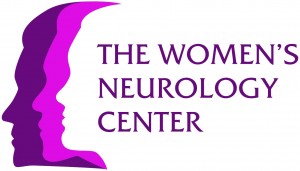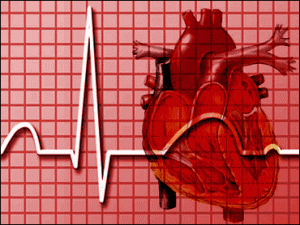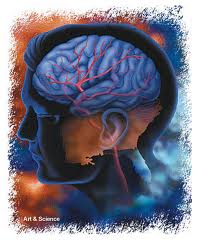 A new AHRQ-funded study suggests that emergency department physicians should be especially vigilant for the possibility of stroke in younger, female and nonwhite patients who complain of headache or dizziness. Based on AHRQ Healthcare Cost and Utilization Project data from 2008 and 2009, study authors estimated that as many as 165,000 strokes are misdiagnosed annually in the emergency department. Potential misdiagnoses were more often associated with younger, female and minority patients who had headache and dizziness. Titled “Missed Diagnosis of Stroke in the Emergency Department: A Cross-Sectional Analysis of a Large Population-Based Sample,” the article was published online April 3 in Diagnosis.
A new AHRQ-funded study suggests that emergency department physicians should be especially vigilant for the possibility of stroke in younger, female and nonwhite patients who complain of headache or dizziness. Based on AHRQ Healthcare Cost and Utilization Project data from 2008 and 2009, study authors estimated that as many as 165,000 strokes are misdiagnosed annually in the emergency department. Potential misdiagnoses were more often associated with younger, female and minority patients who had headache and dizziness. Titled “Missed Diagnosis of Stroke in the Emergency Department: A Cross-Sectional Analysis of a Large Population-Based Sample,” the article was published online April 3 in Diagnosis.
 In early February, the American Heart Association published new guidelines aimed at preventing stroke in women. Due to several factors, women are more prone to stroke and generally have more difficulty recovering from stroke than men. A stroke occurs when a blood clot forms in a vessel leading to the brain, cutting off its oxygen supply. Women suffer strokes more often than men because they tend to live longer than men, undergo reproductive hormonal changes through contraceptives and hormone replacement therapies, and face an increased risk of stroke during pregnancy.
In early February, the American Heart Association published new guidelines aimed at preventing stroke in women. Due to several factors, women are more prone to stroke and generally have more difficulty recovering from stroke than men. A stroke occurs when a blood clot forms in a vessel leading to the brain, cutting off its oxygen supply. Women suffer strokes more often than men because they tend to live longer than men, undergo reproductive hormonal changes through contraceptives and hormone replacement therapies, and face an increased risk of stroke during pregnancy.
Due to these risk factors, the American Heart Association outlines the following guidelines:
- Women with a history of high blood pressure before pregnancy may be able to take low-dose aspirin after the first trimester of pregnancy. Similarly, pregnant women with moderately high blood pressure may be able to be treated with medication.
- A history of preeclampsia, or high blood pressure during pregnancy, should be considered a risk factor for stroke, along with cholesterol, obesity and smoking.
- Women should be tested for high blood pressure prior to starting hormonal birth control, and although data is conflicting, hormone replacement therapy during menopause may increase the risk of stroke, so should not be used for stroke prevention.
- As migraines with aura (sensory warning signs, such as tingling sensations or flashing lights) have been linked to stroke, women who experience migraines with aura should quit smoking.
- Women over 75 should be tested for atrial fibrillation, another risk factor of stroke.
It is vital that stroke awareness and prevention begins at an early age and that blood pressure is monitored and treated appropriately throughout a woman's life. It is also important to note that these are only guidelines and that cases will vary by individual, so it is important to discuss issues or concerns related to stroke with your doctor.
Source: Walton, Alice G. "A Woman's Guide to Stroke Prevention." Forbes. 7 February 2014.
The relative risks of thrombotic stroke and myocardial infarction (MI) are higher among users of hormonal contraception, although absolute risks remain low, a Danish study conducted at Copenhagen University showed.
Use of oral contraceptives combining low-to-moderate doses of ethinyl estradiol and various progestins was associated with up to 2.3 times the risks of thrombotic stroke or MI compared with non-use.The type of progestin in the pill had little effect on the risks, the researchers reported in the June 14 issue of the New England Journal of Medicine.
To put the risk in perspective, they estimated that among 10,000 women taking a pill combining desogestrel with ethinyl estradiol at a dose of 20 μg for 1 year, two will have arterial thrombosis and seven will have venous thrombosis.
"Although venous thrombosis is three to four times as frequent as arterial thrombosis among young women, the latter is associated with higher mortality and more serious consequences for the survivors," they wrote. "Therefore, these figures should be taken into account when prescribing hormonal contraception."
Several previous studies have examined the relationship between hormonal contraceptive use and the risk of venous thromboembolism. But fewer have looked at arterial complications like thrombotic stroke and MI, and the results have been mixed.
In an accompanying editorial, Diana Petitti, MD, MPH, of Arizona State University in Tempe, said that the absolute increases in the risks of thrombotic stroke and MI observed in the study were small."None of the hormonal contraceptives studied ... were associated with an excess risk of stroke that was unacceptable, considering their contraceptive and noncontraceptive benefits," she wrote.
And, she added, evidence from previous studies "shows that the small risk could be minimized and perhaps eliminated by abstinence from smoking and by checking blood pressure, with avoidance of hormonal contraceptive use if blood pressure is raised."
The researchers acknowledged the study was limited by possible diagnostic misclassification, the potential for a time lag between the date of prescription and when the contraceptives were started, the lack of information on body mass index, and the incomplete information on smoking status.
Source reference:
Lidegaard Ø, et al "Thrombotic stroke and myocardial infarction with hormonal contraception" N Engl J Med 2012; 366: 2257-2566.
 Conditions that affect the brain can be more complicated in women compared to men, partly because of hormones and reproductive issues. Did you know:
Conditions that affect the brain can be more complicated in women compared to men, partly because of hormones and reproductive issues. Did you know:
- Twenty percent of women have migraines
- Primary care doctors often ignore sleep disorders in women
- Epilepsy and its treatment can be impacted by hormonal cyclic changes
- Neurologic treatments interfere with contraceptive effectiveness and fertility
- Stroke mortality is higher in women than men but 30% of women are unaware of this fact.
To address these concerns at NorthwesternMedicine, a group of neurology specialists who have a strong interest in women's health and sex-specific care have opened the Women's Neurology Clinic at Northwestern. The center plans to incorporate integrated medicine approaches and not rely solely on pharmacologic interventions. To learn more about this clinic, visit their website.
 A hike in your blood pressure during middle age significantly raises the risk of having a heart attack or a stroke during your lifetime, according to new Northwestern Medicine research. The study offers a new understanding on the importance of maintaining low blood pressure early in middle age to prevent heart disease later in life.
A hike in your blood pressure during middle age significantly raises the risk of having a heart attack or a stroke during your lifetime, according to new Northwestern Medicine research. The study offers a new understanding on the importance of maintaining low blood pressure early in middle age to prevent heart disease later in life.
Men and women who developed high blood pressure in middle age or who started out with high blood pressure had an estimated 30 percent increased risk of having a heart attack or stroke compared to those who kept their blood pressure low.
Previous estimates of a person’s risk of cardiovascular disease were based on a single blood pressure measurement. The higher the blood pressure reading, the greater the risk. The new Northwestern Medicine study expands on that by showing a more accurate predictor is a change in blood pressure from age 41 to 55.
The study is published in Circulation: Journal of the American Heart Association.
“We found the longer we can prevent hypertension or postpone it, the lower the risk for cardiovascular disease,” said lead author Norrina Allen, assistant professor of preventive medicine at Northwestern University Feinberg School of Medicine. “Even for people with normal blood pressure, we want to make sure they keep it at that level, and it doesn’t start increasing over time.”
“There hasn’t been as much of a focus on keeping it low when people are in their 40’s and 50’s,” Allen added. “That’s before a lot of people start focusing on cardiovascular disease risk factors. We’ve shown it’s vital to start early.” People that maintain or reduce their blood pressure to normal levels by age 55 have the lowest lifetime risk for a heart attack or a stroke.
Men who developed high blood pressure in middle age or who started out with high blood pressure had a 70 percent risk of having a heart attack or stroke compared to a 41 percent risk for men who maintained low blood pressure or whose blood pressure decreased during the time period. Women who developed high blood pressure had almost a 50 percent risk of a heart attack or stroke compared to a 22 percent risk for those who kept their blood pressure low or saw a decrease.
Men generally have a 55 percent risk of cardiovascular disease in their lifetimes; women have a 40 percent risk.
The research was supported by the National Heart, Lung and Blood Institute.
By Marla Paul -- NU health sciences editor
 Heart disease and stroke deaths drop significantly for people with diabetes!
Heart disease and stroke deaths drop significantly for people with diabetes!
According to the Centers for Disease Control and Prevention (CDC) healthier lifestyles, better disease management are helping people with diabetes live longer. Death rates for people with diabetes dropped substantially from 1997 to 2006, according to a study published May 22 in the journal Diabetes Care. Among the most promising findings,
- Deaths from all causes declined by 23%.
- Deaths related to heart disease and stroke dropped by 40%.
- Although an adult with diabetes is likely to die at a younger age than one who does not have diabetes, the difference is getting smaller.
These findings parallel other surveillance reports showing improved medical treatment for cardiovascular disease, better management of diabetes, and some healthy lifestyle changes contributed to the decline. On average, people with diabetes were less likely to smoke and more likely to be physically active than in the past. Better control of high blood pressure and high cholesterol also may have contributed to improved health among diabetics. However, obesity levels among people with diabetes continued to increase ☹.
 Between 2000 and 2007, the death rate of men treated in hospitals for stroke tumbled by 29 percent compared to a 24 percent decline for women, according to the latest News and Numbers from the Agency for Healthcare Research and Quality (AHRQ).
Between 2000 and 2007, the death rate of men treated in hospitals for stroke tumbled by 29 percent compared to a 24 percent decline for women, according to the latest News and Numbers from the Agency for Healthcare Research and Quality (AHRQ).
Men's faster decline in death rate widened the death rate disparity even more. Men's death rate for every 1,000 admissions for stroke went from 123 in 2000 to 87 in 2009, compared with women's 127 deaths in 2000 to 96 deaths per 1,000 admissions in 2007.
The Federal agency found other gender variations in hospital deaths rates during the period as well:
- Men's heart failure death rate fell by 52 percent compared with women's 46 percent. But men were about as likely to die from heart failure in 2007 as women—28 deaths versus 29 deaths, respectively, per 1,000 admissions.
- Conversely, women's heart attack death rate fell slightly more than men's—39 percent versus 37 percent. But by 2007, women hospitalized for heart attack were still more likely than men to die—77 deaths versus men's 58 death per 1,000 heart attack admissions.
- Regardless of gender, people who had private insurance experienced decreases in heart attack and heart failure death rates of 32 percent and 41 percent, respectively while Medicaid patients experienced declines of 27 percent and 34 percent for the same conditions. Medicare patients' death rates fell by 38 percent and 51 percent—the most for both conditions.
This AHRQ News and Numbers is based on data in Trends in Hospital Risk-Adjusted Mortality for Selected Diagnoses by Patient Subgroups, 2000-2007.
 Aspirin therapy to prevent heart attack may have different benefits and harms in men and women.
Aspirin therapy to prevent heart attack may have different benefits and harms in men and women.
Cardiovascular disease (CVD) is the leading cause of death in the U.S., contributing to approximately 58% of deaths. The epidemiology of CVD events is different for men and women. Men have a higher risk for coronary heart disease and tend to have these events at a younger age than women.
Although incidence rates of stroke are higher among men than women, more women die of stroke than men because of their longer life expectancy.
Back in 2002, the US Preventive Services Task Force (USPSTF) strongly recommended that clinicians discuss aspirin with adults who are at increased risk for coronary heart disease. This preventive measure was based on 5 randomized controlled trials that showed a 28% reduction in myocardial infarctions (heart attack) with aspirin use. Only 2 of 5 studies included women! At that time it was not clear if the earlier recommendation base on mainly male dominated studies was valid for women. In 2005, the large Women's Health Initiative (WHI) provided some new data about the benefits of aspirin in women but confusion continued.
In March 2009, the U.S. Preventive Services Task Force reviewed new evidence from NIH's Women's Health Study and other recent research and found good evidence that aspirin decreases first heart attacks in men and first strokes in women. The Task Force has issued a recommendation that women between the ages of 55 and 70 should use aspirin to reduce their risk for ischemic stroke (lack of blood and oxygen due to a clot or other disease process) when the benefits outweigh the harms for potential gastrointestinal bleeding.
In summary, as of March 2009, the USPSTF recommends:
- The use of aspirin for men age 45-79 years when the potential benefit due to reduction in myocardial infarctions outweigh the potential harm due to an in increase in GI bleeding.
- The use of aspirin for women age 55-79 when the potential benefit of a reduction in ischemic strokes outweighs the potential harm of an increase in GI bleeding.
- The current evidence is insufficient to assess the balance of benefits and harms of aspirin for cardiovascular disease prevention in men and women 80 years or older.
- Against the use of aspirin for stroke prevention in women younger than 55 years and for myocardial infarction prevention in men younger than 45 years.
The new report does conclude that aspirin increases the risk for major bleeding events, primarily GI bleeding in both men and women. There is also limited evidence that hemorrhagic strokes are significantly increased among men but not women.
As with other studies we have cited on this blog, recommendations are always subject to change as new research is completed. It is wise to discuss your individual concerns with your physician because other health factors could influence your decisions. The entire discussion above also reinforces the need for ALL research to look at sex and gender differences even in the most basic trials so that when we want to apply findings to humans, we already know if there are sex differences --- as we are finding out about aspirin therapy.
The recommendation and other materials are available at  U.S. Preventive Services Task Force, Ann Intern Med 150(6):396-404, 2009 (AHRQ supports the Task Force). See also Optowsky, McWilliams, and Cannon, J Gen Intern Med 22:55-61, 2007 (AHRQ grant T32 HS00020).
U.S. Preventive Services Task Force, Ann Intern Med 150(6):396-404, 2009 (AHRQ supports the Task Force). See also Optowsky, McWilliams, and Cannon, J Gen Intern Med 22:55-61, 2007 (AHRQ grant T32 HS00020).
